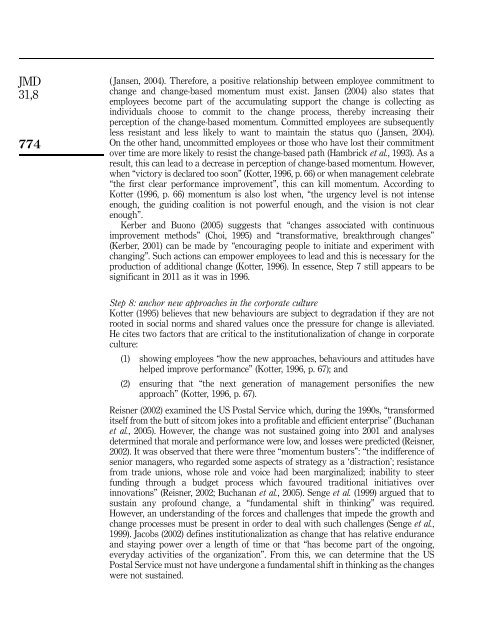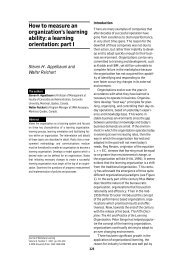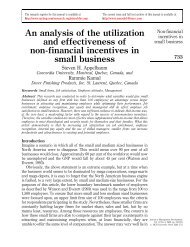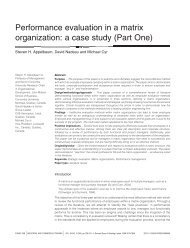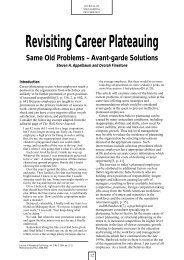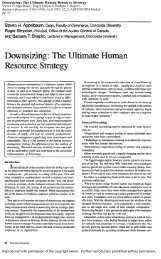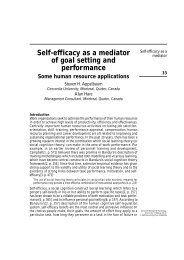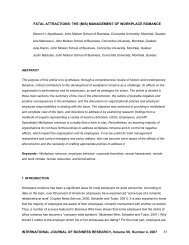Back to the future: revisiting Kotter's - Dr. Steven H. Appelbaum ...
Back to the future: revisiting Kotter's - Dr. Steven H. Appelbaum ...
Back to the future: revisiting Kotter's - Dr. Steven H. Appelbaum ...
Create successful ePaper yourself
Turn your PDF publications into a flip-book with our unique Google optimized e-Paper software.
JMD<br />
31,8<br />
774<br />
( Jansen, 2004). Therefore, a positive relationship between employee commitment <strong>to</strong><br />
change and change-based momentum must exist. Jansen (2004) also states that<br />
employees become part of <strong>the</strong> accumulating support <strong>the</strong> change is collecting as<br />
individuals choose <strong>to</strong> commit <strong>to</strong> <strong>the</strong> change process, <strong>the</strong>reby increasing <strong>the</strong>ir<br />
perception of <strong>the</strong> change-based momentum. Committed employees are subsequently<br />
less resistant and less likely <strong>to</strong> want <strong>to</strong> maintain <strong>the</strong> status quo ( Jansen, 2004).<br />
On <strong>the</strong> o<strong>the</strong>r hand, uncommitted employees or those who have lost <strong>the</strong>ir commitment<br />
over time are more likely <strong>to</strong> resist <strong>the</strong> change-based path (Hambrick et al., 1993). As a<br />
result, this can lead <strong>to</strong> a decrease in perception of change-based momentum. However,<br />
when “vic<strong>to</strong>ry is declared <strong>to</strong>o soon” (Kotter, 1996, p. 66) or when management celebrate<br />
“<strong>the</strong> first clear performance improvement”, this can kill momentum. According <strong>to</strong><br />
Kotter (1996, p. 66) momentum is also lost when, “<strong>the</strong> urgency level is not intense<br />
enough, <strong>the</strong> guiding coalition is not powerful enough, and <strong>the</strong> vision is not clear<br />
enough”.<br />
Kerber and Buono (2005) suggests that “changes associated with continuous<br />
improvement methods” (Choi, 1995) and “transformative, breakthrough changes”<br />
(Kerber, 2001) can be made by “encouraging people <strong>to</strong> initiate and experiment with<br />
changing”. Such actions can empower employees <strong>to</strong> lead and this is necessary for <strong>the</strong><br />
production of additional change (Kotter, 1996). In essence, Step 7 still appears <strong>to</strong> be<br />
significant in 2011 as it was in 1996.<br />
Step 8: anchor new approaches in <strong>the</strong> corporate culture<br />
Kotter (1995) believes that new behaviours are subject <strong>to</strong> degradation if <strong>the</strong>y are not<br />
rooted in social norms and shared values once <strong>the</strong> pressure for change is alleviated.<br />
He cites two fac<strong>to</strong>rs that are critical <strong>to</strong> <strong>the</strong> institutionalization of change in corporate<br />
culture:<br />
(1) showing employees “how <strong>the</strong> new approaches, behaviours and attitudes have<br />
helped improve performance” (Kotter, 1996, p. 67); and<br />
(2) ensuring that “<strong>the</strong> next generation of management personifies <strong>the</strong> new<br />
approach” (Kotter, 1996, p. 67).<br />
Reisner (2002) examined <strong>the</strong> US Postal Service which, during <strong>the</strong> 1990s, “transformed<br />
itself from <strong>the</strong> butt of sitcom jokes in<strong>to</strong> a profitable and efficient enterprise” (Buchanan<br />
et al., 2005). However, <strong>the</strong> change was not sustained going in<strong>to</strong> 2001 and analyses<br />
determined that morale and performance were low, and losses were predicted (Reisner,<br />
2002). It was observed that <strong>the</strong>re were three “momentum busters”: “<strong>the</strong> indifference of<br />
senior managers, who regarded some aspects of strategy as a ‘distraction’; resistance<br />
from trade unions, whose role and voice had been marginalized; inability <strong>to</strong> steer<br />
funding through a budget process which favoured traditional initiatives over<br />
innovations” (Reisner, 2002; Buchanan et al., 2005). Senge et al. (1999) argued that <strong>to</strong><br />
sustain any profound change, a “fundamental shift in thinking” was required.<br />
However, an understanding of <strong>the</strong> forces and challenges that impede <strong>the</strong> growth and<br />
change processes must be present in order <strong>to</strong> deal with such challenges (Senge et al.,<br />
1999). Jacobs (2002) defines institutionalization as change that has relative endurance<br />
and staying power over a length of time or that “has become part of <strong>the</strong> ongoing,<br />
everyday activities of <strong>the</strong> organization”. From this, we can determine that <strong>the</strong> US<br />
Postal Service must not have undergone a fundamental shift in thinking as <strong>the</strong> changes<br />
were not sustained.


